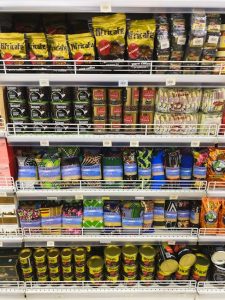The Rise of Couscous in American Cuisine: A Delicious Journey
Couscous, a staple grain in North African cuisine, has been making its way onto American plates with increasing frequency. Its delicate texture, versatility, and unique flavor profile have captured the hearts and palates of American food enthusiasts. This journey of couscous from its origins in the Maghreb region to the kitchens of America is a testament to its culinary prowess and adaptability. The history of couscous dates back centuries, with evidence suggesting its origins in the Berber culture of North Africa. Traditionally, couscous was prepared using a hand-cranked device called a “keskes” to create the small, pearl-like grains. This preparation method, passed down through generations, has been modernized over time. Still, the essence of couscous remains the same: a simple yet flavorful grain that forms the foundation of countless dishes.
The appeal of couscous lies in its simplicity and adaptability. It can be cooked in various ways, from steaming to simmering, and is easily paired with multiple ingredients. This versatility makes it a favorite for home cooks and professional chefs, who can create everything from light and refreshing salads to hearty and flavorful main courses. For instance, a classic dish, Moroccan couscous, is cooked in a savory broth with vegetables, meat, and spices. In contrast, a simple couscous salad can be made with fresh vegetables, herbs, and a light vinaigrette, offering a refreshing and healthy meal option. The adaptability of couscous extends beyond traditional North African cuisine, making it a popular ingredient in fusion dishes and modern culinary creations.
Beyond its culinary versatility, couscous also boasts impressive nutritional benefits. It is a good source of fiber, which aids digestion and helps regulate blood sugar levels. Additionally, it is gluten-free, making it a suitable option for individuals with gluten sensitivities or celiac disease. In a world increasingly focused on healthy eating, couscous has emerged as a viable and delicious alternative to traditional pasta and rice. A cup of cooked couscous contains approximately 17 grams of carbohydrates, 4 grams of protein, and 1 gram of fat. It is also a good source of manganese, magnesium, and phosphorus, all essential minerals for overall health. The nutritional profile of couscous and its versatility and delicious flavor have contributed to its growing popularity in the American culinary landscape.
The rise of couscous in America can be attributed to several factors, including the increasing popularity of international cuisine, the growing awareness of healthy eating, and the rise of food blogs and social media platforms that showcase diverse culinary experiences. The availability of pre-packaged couscous in supermarkets across the country has also made it easier for Americans to incorporate this versatile grain into their diets. Moreover, the growing number of restaurants featuring couscous-based dishes has introduced this ingredient to a broader audience, further fueling its popularity.
This article will explore the fascinating journey of couscous in America, exploring its history, cultural significance, and ever-growing popularity. We will discuss its nutritional benefits, explore popular recipes, and uncover the reasons behind its increasing appeal in American cuisine. By understanding the evolution of couscous in America, we can appreciate its unique place in the diverse tapestry of American cuisine and its potential to continue captivating taste buds nationwide.
The History of Couscous in America
While couscous has been a staple in North African cuisine for centuries, its journey to America is relatively recent. The introduction of couscous to the United States is primarily attributed to the growing popularity of Mediterranean and Middle Eastern cuisines in the 1970s and 1980s. As American consumers became increasingly exposed to global flavors, couscous found a new home in American kitchens. This exposure was fueled by the rise of international restaurants, cookbooks, and television programs showcasing the world’s diverse and flavorful cuisines. The influx of immigrants from North Africa and the Middle East also contributed to introducing couscous into American culinary traditions.
The availability of couscous in American supermarkets expanded significantly during this period, making it easily accessible to home cooks. This accessibility, versatility, and nutritional benefits contributed to its growing popularity. Couscous quickly became a favored ingredient for health-conscious individuals seeking alternative grains and a delicious way to incorporate diverse flavors into their meals. The rise of the health food movement in the 1980s and 1990s further fueled the popularity of couscous as consumers sought healthier alternatives to traditional white rice and pasta. This trend continues today, with couscous being a popular choice among those following gluten-free, vegan, and vegetarian diets.
The Versatility of Couscous: From Side Dish to Main Course
The versatility of couscous lies in its ability to adapt to a wide array of flavors and culinary styles. It can be used as a base for salads, a side dish accompanying roasted vegetables and grilled meats, or as the foundation for hearty stews and flavorful pasta-like dishes. Its neutral flavor makes it an ideal canvas for incorporating spices, herbs, and sauces, allowing for endless culinary creativity. For instance, couscous can create a vibrant Moroccan tagine, a hearty lentil soup, or a refreshing summer salad with fresh vegetables and herbs.
A simple couscous salad can be a refreshing and healthy lunch or a side dish with fresh vegetables, herbs, and a light vinaigrette. For a more substantial meal, couscous can be combined with roasted chicken or vegetables and flavored with cumin, coriander, and turmeric. The possibilities are endless, limited only by the imagination of the cook. Chefs and home cooks alike have embraced couscous as a versatile ingredient, creating innovative and delicious dishes that showcase its culinary potential. From upscale restaurants to casual eateries, couscous has become a staple ingredient in American cuisine.
The Health Benefits of Couscous
Couscous offers a range of health benefits, making it a popular choice for health-conscious individuals. Its high fiber content aids digestion, promotes regularity, and helps regulate blood sugar levels. The fiber in couscous also helps keep you full and satisfied, making it an ideal choice for weight management. Additionally, couscous is a good source of manganese, a mineral that plays a crucial role in bone health and metabolism. Studies have shown that diets rich in fiber, like those that include couscous, can help reduce the risk of chronic diseases such as heart disease, type 2 diabetes, and certain types of cancer.
Another significant benefit of couscous is its gluten-free nature. This makes it suitable for individuals with gluten sensitivities or celiac disease, providing a delicious and safe alternative to traditional pasta and rice. The gluten-free nature of couscous has also contributed to its growing popularity among those following a gluten-free diet. As awareness of gluten sensitivities and celiac disease has increased, couscous has emerged as a valuable and delicious alternative for those seeking gluten-free options.
Popular Couscous Recipes
With its versatility and adaptability, couscous has become a staple ingredient in many American kitchens. Here are a few popular and delicious couscous recipes that showcase its diverse culinary potential:
**Moroccan Couscous with Vegetables:** This classic North African dish features couscous cooked in a flavorful broth, accompanied by a medley of roasted vegetables like carrots, zucchini, and bell peppers. The dish is typically seasoned with aromatic spices, including cumin, coriander, and turmeric, and often garnished with fresh cilantro and chopped almonds. This recipe is a delicious and healthy way to enjoy the vibrant flavors of Moroccan cuisine.
**Lemon-Herb Couscous Salad:** This refreshing and light salad features couscous tossed with chopped vegetables, herbs, and a tangy lemon vinaigrette. You can customize it with your favorite vegetables, such as cucumbers, tomatoes, bell peppers, and red onion. This salad is perfect for a light lunch or a side dish for grilled fish or chicken.
**Couscous Stuffed Peppers:** This hearty and flavorful dish features bell peppers stuffed with a mixture of couscous, ground meat, vegetables, and spices. The peppers are baked until tender, creating a satisfying and comforting meal. This recipe is a great way to incorporate couscous into a main course and can be customized with different fillings and spices to suit your taste.
The Future of Couscous in America
The popularity of couscous in America continues to grow, driven by its versatility, nutritional benefits, and increasing accessibility. As American consumers become more interested in global cuisines and healthy eating, couscous is poised to become an even more prominent ingredient in American kitchens. With its adaptability and endless culinary possibilities, couscous will remain a beloved staple for years. The rise of food blogs, social media platforms, and cooking shows dedicated to showcasing global cuisines has further contributed to the growing popularity of couscous in America. These platforms provide recipes, tips, and inspiration for incorporating couscous into various dishes, further expanding its culinary reach.
The growing trend of plant-based and vegan diets is also likely to fuel the popularity of couscous. As a gluten-free and vegan-friendly grain, couscous offers a delicious and healthy alternative to traditional pasta and rice, further expanding its reach in the American culinary landscape. With its versatility, nutritional benefits, and growing popularity among health-conscious consumers, couscous is poised to continue its delicious journey in American cuisine for years.
From its humble origins in North Africa to its growing popularity in American kitchens, couscous has embarked on a remarkable culinary journey. Its versatility, nutritional value, and delightful flavor have captivated palates nationwide, making it a beloved ingredient in countless dishes. Couscous’s adaptability shines through in its ability to seamlessly integrate into various cuisines, from traditional Moroccan tagines to contemporary salads and grain bowls. Its delicate texture and subtle nutty flavor complement various ingredients, allowing chefs and home cooks to explore endless culinary possibilities.
The rising popularity of couscous in America can be attributed to several factors. The growing interest in global cuisines and the desire for authentic flavors have fueled the demand for this versatile grain. Furthermore, the increasing emphasis on healthy eating has propelled couscous to the forefront of culinary trends. Couscous is a good source of fiber, protein, and essential vitamins and minerals, making it a nutritious and satisfying addition to any meal. Its low glycemic index also contributes to its appeal, providing a slow and steady release of energy and promoting sustained satiety and blood sugar control.
The culinary landscape of America is constantly evolving, and couscous has become an integral part of this dynamic scene. From upscale restaurants to home kitchens, this versatile grain has found a place in the hearts and stomachs of Americans. Its adaptability allows it to be incorporated into various dishes, catering to diverse tastes and dietary preferences. Whether it’s a simple side dish, a flavorful salad, or a hearty main course, couscous offers a delicious and nutritious option that satisfies both the palate and the body.
As American consumers continue to explore new culinary horizons and prioritize healthy eating, couscous is poised to remain a culinary staple for years. Its versatility, nutritional value, and delicious flavor make it a perfect choice for those seeking flavorful and wholesome meals. So, the next time you’re looking for a tasty and healthy meal, consider incorporating couscous into your culinary repertoire. Explore this versatile grain’s endless possibilities and discover a world of flavor and culinary creativity. You might find yourself adding this North African staple to your list of favorite ingredients.

Photo by Vincenzo Iorio on Pexels







Can you be more specific about the content of your article? After reading it, I still have some doubts. Hope you can help me.